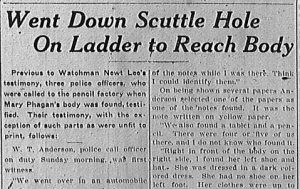 Another in our series of new transcriptions of contemporary articles on the Leo Frank case.
Another in our series of new transcriptions of contemporary articles on the Leo Frank case.
Atlanta Georgian
Wednesday April 30th, 1913
Previous to Watchman Newt Lee’s testimony, three police officers, who were called to the pencil factory when Mary Phagan’s body was found, testified. Their testimony, with the exception of such parts as were unfit to print, follows:
W. T. Anderson, police call officer on duty Sunday morning, was first witness.
“We went over in an automobile to the pencil factory and the negro took us into the cellar where the body was found,” he said.
Anderson told of the location of the scuttle hole, from which a ladder led to the basement, and of the location of the body.
“At the foot of the ladder I did not find anything,” he went on. “On the left of the basement is a partition part of the way, forming a room. The body was at the lower end of the partition, a few inches from the partition and about six feet from the outside wall of the building. Her head was toward the front of the building. She was lying on her face. The cellar was very dark.
“I did not see the body until I reached it. There is a toilet on the opposite side of the basement, on the right side next to the boiler. There was rubbish, shavings and the like. I did not see any white trash lying about.
“Sergeant Dobbs picked up one of the notes while I was there. Think I could identify them.”
On being shown several papers Anderson selected one of the papers as one of the notes found. It was the note written on yellow paper.
“We also found a tablet and a pencil. There were four or five of us there, and I do not know who found it.
“Right in front of the body on the right side, I found her left shoe and hat. She was dressed in a dark colored dress. She had no shoe on her left foot. Her clothes were up to her knees.
“Her left leg just below the knee the stocking was torn and her leg skinned. There was blood on her head, while her eyes were bloodshot. A piece of wrapping cord and her underskirt band were tied around her neck. There was a cut on the back side of her head by the left temple. Her mouth and eyes were filled with dirt and sawdust. She was covered with so much dirt that I could not tell whether she was white or black, and had to pull down one of her stockings to tell whether she was white. Her legs below her knees were also covered with dirt and sawdust.
Staple Pulled From Door.
“There was a staple pulled out of the lock at the back door. It is a side door. It has a bar with a hasp. There was a lock in the staple, but the door was closed. There was a lock in the staple, but the door was closed. Sergeant Dobbs and Brown were there before me.”
“There was blood on her head, stomach and legs. I had a flashlight with me. The watchman had an ordinary lantern, the globe of which was smoked. It did not give much light.
“It was about 25 or 30 feet from negro’s toilet to where the body was lying. I could not see the body from there with his lantern, could not see over 10 or 12 feet with it.
“She had on a white underskirt. Her head was in line with the corner of the partition. A flashlight would have shown the body. It struck me that she would have been too far behind the partition for the lantern light to show her.
What Negro “Thought at First.”
“The negro watchman told me when he saw the body at first he thought some one had placed something there to scare him. He said he did not go down there very much, going down that time to the toilet.
“I questioned the negro at length. He said the toilet in basement was for negroes.
“After questioning the negro, I called Frank at his residence, but could not get him. I then called Mr. Haas, of the National Pencil Company. One of the women members of the family talked to me. Sergeant Brown instructed me to call some of the head men of the pencil company.”
Officer Anderson identified the clothing worn by the girl when he found her in the basement. He was then dismissed.
Officer Anderson was called in again and asked to identify the dead girl’s clothing. In answer to a question, he said the girl’s stocking supporters were unfastened.
Q.—Did the negro say it was a white woman or a negro when he telephoned? A.—He said: “A white woman has been killed up here.”
Q.—Did he tell you how she was lying? A.—He said she was on her back.
Negro Was Excited.
Q.—Was he excited? A.—Yes.
Q.—How long do you think the girl had been dead? A.—I don’t know much about that, but she was not much right.
Q.—Were there any signs of a scuffle? A.—Behind where she was lying there were evidence of a struggle. We found a bloody handkerchief seven or eight feet from the body.
Q.—Did you see a handbag? A.—I did not. I did not see any evidences of her pay envelope.
Q.—What kind of investigation did you make? A.—The first thing we did was to look for the left shoe. We did not make any investigation on the second floor.
* * *
Atlanta Georgian, April 30th 1913, “Went Down Scuttle Hole on Ladder to Reach Body,” Leo Frank case newspaper article series (Original PDF)
